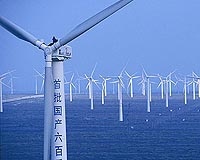 |
Albuquerque NM (SPX) Mar 07, 2011 Sandia National Laboratories researchers are moving into the demonstration phase of a novel gas turbine system for power generation, with the promise that thermal-to-electric conversion efficiency will be increased to as much as 50 percent - an improvement of 50 percent for nuclear power stations equipped with steam turbines, or a 40 percent improvement for simple gas turbines. The system is also very compact, meaning that capital costs would be relatively low. Research focuses on supercritical carbon dioxide (S-CO2) Brayton-cycle turbines, which typically would be used for bulk thermal and nuclear generation of electricity, including next-generation power reactors. The goal is eventually to replace steam-driven Rankine cycle turbines, which have lower efficiency, are corrosive at high temperature and occupy 30 times as much space because of the need for very large turbines and condensers to dispose of excess steam. The Brayton cycle could yield 20 megawatts of electricity from a package with a volume as small as four cubic meters. The Brayton cycle, named after George Brayton, originally functioned by heating air in a confined space and then releasing it in a particular direction. The same principle is used to power jet engines today. "This machine is basically a jet engine running on a hot liquid," said principal investigator Steve Wright of Sandia's Advanced Nuclear Concepts group. "There is a tremendous amount of industrial and scientific interest in supercritical CO2 systems for power generation using all potential heat sources including solar, geothermal, fossil fuel, biofuel and nuclear." Sandia currently has two supercritical CO2 test loops. (The term "loop" derives from the shape taken by the working fluid as it completes each circuit.) A power production loop is located at the Arvada, Colo., site of contractor Barber Nichols Inc., where it has been running and producing approximately 240 kilowatts of electricity during the developmental phase that began in March 2010. It is now being upgraded and is expected to be shipped to Sandia this summer. A second loop, located at Sandia in Albuquerque, is used to research the unusual issues of compression, bearings, seals, and friction that exist near the critical point, where the carbon dioxide has the density of liquid but otherwise has many of the properties of a gas. Immediate plans call for Sandia to continue to develop and operate the small test loops to identify key features and technologies. Test results will illustrate the capability of the concept, particularly its compactness, efficiency and scalability to larger systems. Future plans call for commercialization of the technology and development of an industrial demonstration plant at 10 MW of electricity. A competing system, also at Sandia and using Brayton cycles with helium as the working fluid, is designed to operate at about 925 degrees C and is expected to produce electrical power at 43 percent to 46 percent efficiency. By contrast, the supercritical CO2 Brayton cycle provides the same efficiency as helium Brayton systems but at a considerably lower temperature (250-300 C). The S-CO2 equipment is also more compact than that of the helium cycle, which in turn is more compact than the conventional steam cycle. Under normal conditions materials behave in a predictable, classical, "ideal" way as conditions cause them to change phase, as when water turns to steam. But this model tends not to work at lower temperatures or higher pressures than those that exist at these critical points. In the case of carbon dioxide, it becomes an unusually dense "supercritical" liquid at the point where it is held between the gas phase and liquid phase. The supercritical properties of carbon dioxide at temperatures above 500 C and pressures above 7.6 megapascals enable the system to operate with very high thermal efficiency, exceeding even those of a large coal-generated power plant and nearly twice as efficient as that of a gasoline engine (about 25 percent). In other words, as compared with other gas turbines the S-CO2 Brayton system could increase the electrical power produced per unit of fuel by 40 percent or more. The combination of low temperatures, high efficiency and high power density allows for the development of very compact, transportable systems that are more affordable because only standard engineering materials (stainless steel) are required, less material is needed, and the small size allows for advanced-modular manufacturing processes. "Sandia is not alone in this field, but we are in the lead," Wright said. "We're past the point of wondering if these power systems are going to be developed; the question remains of who will be first to market. Sandia and DOE have a wonderful opportunity in the commercialization effort." Sandia's S-CO2 Brayton cycle program is supported by DOE with funding from the Labs' Laboratory Directed Research and Development (LDRD) program.
Share This Article With Planet Earth
Related Links Sandia National Laboratories Powering The World in the 21st Century at Energy-Daily.com
 China pledges 'green' push over next five years
China pledges 'green' push over next five yearsBeijing (AFP) March 5, 2011 Premier Wen Jiabao on Saturday pledged that China, the world's top emitter of greenhouse gases, would work harder to save energy and clean up the air as it revamps the economy over the next five years. "We will effectively conserve resources and protect the environment. We will respond actively to climate change," Wen said in a speech to open the annual session of China's parliament, or Nati ... read more |
|
| The content herein, unless otherwise known to be public domain, are Copyright 1995-2010 - SpaceDaily. AFP and UPI Wire Stories are copyright Agence France-Presse and United Press International. ESA Portal Reports are copyright European Space Agency. All NASA sourced material is public domain. Additional copyrights may apply in whole or part to other bona fide parties. Advertising does not imply endorsement,agreement or approval of any opinions, statements or information provided by SpaceDaily on any Web page published or hosted by SpaceDaily. Privacy Statement |